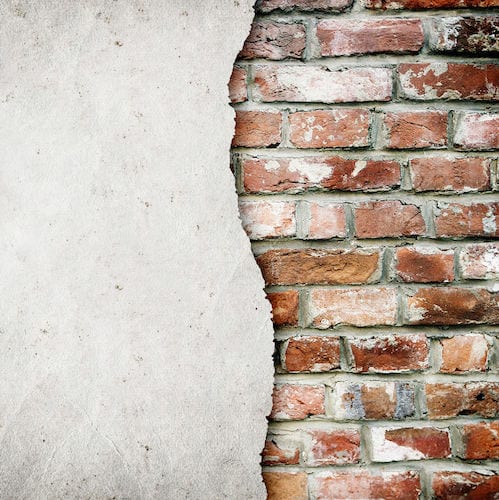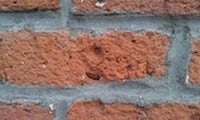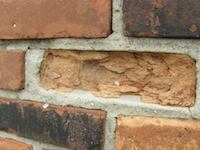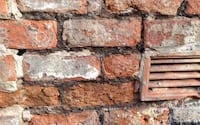 Old brick buildings across the country have a tendency to get painted over the years by owners looking to “improve” their look. Whether its just a chimney or the whole building that’s been painted, a lot of us want to go back to that original brick look.
Old brick buildings across the country have a tendency to get painted over the years by owners looking to “improve” their look. Whether its just a chimney or the whole building that’s been painted, a lot of us want to go back to that original brick look.
So how do you strip paint from century old brick? Well, the first thought a lot of folks have is sandblasting old brick. There are countless videos and well meaning bloggers who will tell you that sandblasting is the answer, but what they won’t show you is what happens after sandblasted brick is exposed to the elements for a few months.
In this post I’ll show you the dangers of sandblasting old brick and how that can take what would have been a relatively low maintenance brick building and turn it into a crumbling maintenance disaster.
How Old Bricks Were Made
In their simplest form brick are just clumps of clay mixed with varying degrees of shale and sand. Until the mid 1800s, most bricks were formed by hand and set out in a brick yard or in tunnels to dry for a couple weeks until they were ready for the kiln.
The kiln was often built using just these “green” bricks as the walls so as to act as their own kiln. The bricks were cooked at a lower initial temperature slowly to remove any remaining water and then once they were dry enough, the fires were stoked to bring the temps up to around 1800°F before letting them slowly cool down.
Once the bricks had cooled enough, the kiln was disassembled and the bricks were sorted. If only raw bricks were used to build the kiln, the bricks from the outermost walls were kept to be burned again in the next kiln. Some bricks that were closest to the fire received a glaze from the sand that fell into the fires and became vaporized and deposited on the bricks. These less attractive bricks were used in the interior courses of the walls. Bricks that became severely over-burned and cracked or warped were called clinkers and were used less for structural purposes and more for decorative uses like gardens.
This early process of making bricks resulted in much softer and less consistent bricks than what we have today. Today, the bricks are fired evenly and under controlled high temperatures where every brick gets the same amount of heat resulting in much harder bricks.
What Sandblasting Does to Old Brick
Imagine that bricks (especially old bricks) are a loaf of bread, after all they were baked much the same way! Just like how a loaf of bread develops a crust as it is baked in the oven, bricks also develop a protective skin on them from the firing process. That skin keeps them protected from the elements and just like bread, without a crust, they won’t last long without it.
Sandblasting old brick removes paint, yes, but it also removes the outer skin, leaving the brick exposed to the elements and susceptible to an early death. Here are some of the biggest problems sandblasting old brick causes.
Spalling
Spalling occurs when the brick slowly self-destructs, turning into a powder and falling apart. Spalling can also occur from repointing with a mortar that is too hard which causes the face of the brick to break off exposing the softer interior. Sandblasting causes this en masse as ALL the sandblasted brick is now exposed and weakened. I’ve seen whole walls turned to powder within months of sandblasting depending on the climate.



Sub-Efflorescence
It’s a big word and it’s as frightening to spell as it is to see. This is not a direct cause of sandblasting, but still an issue because it seems that a lot of people like to sandblast old brick and then apply a sealer to the face to prevent spalling or other damage to the weakened brick. That’s where the problem starts.
Old brick and lime mortar are very breathable building materials that are constantly taking in and expelling water through both sides of the wall. If you seal up one side of the wall, then you prevent that natural breathability from happening.
Moisture builds up within the brick on the underside of the sealer and minerals are deposited just below the surface of the sealer. Eventually this build up can cause the exterior 1/4″ or more of the brick to be forced off the wall and fall to the ground.
Cosmetic Damage
Not only does it damage the structural integrity of the brick, but the appearance of sandblasted brick is destroyed too. Any decorative tuckpointing or tooled mortar joints are blasted away along with the face of the bricks, leaving a uniformly rough scarified surface that doesn’t have the same attractive appearance as the original.
An Alternative to Sandblasting
So, what are you to do if you need to remove paint from old brick? Usually the best solution is chemical paint stripping. Using a product like PeelAway1, I have had great success removing decades of old paint from brick.
You brush the paste onto the brick, cover it in a special paper that comes with it, and come back the next day to peel the paper (along with most of the paint) off the wall.
I’ve written an earlier post about some testing I did with this product. It was tested on wood in the post, but works much the same on brick and other masonry.
I’m hoping that by now I have convinced you to skip sandblasting as a method of paint removal. It works well for stripping some metals and concrete, but other than that it usually creates more problems than it solves.
Protect that old brick and keep the sandblaster away.

Founder & Editor-in-Chief
I love old houses, working with my hands, and teaching others the excitment of doing it yourself! Everything is teachable if you only give it the chance.


Hi Scott, Thank you for sharing this wonderful article. Can you please tell me how can I remove paint from old brick wall? In an article, I read that peeling strips can be used to remove paint from brick surface. ( Here is a link to that article: https://anglianblasting.com/blog/how-to-remove-paint-from-wood-stone-metal-brick-steel/).
Can you please tell me something about these peeling strips and can I use sandblasting to remove paint from bricks?
Thanks.
My 1920s house has brick around the windows and trim.
It has become gray from, I believe sprinkler water hitting it.
Anyway to brighten that brick up?
I have purchased a 1940 Flagstone Home. The mortar tuck points are rounded out and have been painted white with black edges. “Giraffe Home”
I am restoring the home and am considering a lime wash old world look. Will the limewash adhere to the painted mortar joints? If not can I sand blast them alone?
I have an end terece victorian house with a glaze brick finish it was built in 1860 It has been painted a few times throughout the years and now I would like to take it back to the brick what is the best way
Test PeelAway1 chemical stripper in a few test areas. I’ve had good success with it before.
Thorocoat (MasterProtect HB 400) is the standard for coating brick. It is tough and breathable. (Of course I wouldn’t recommend coating your bricks unless they’ve already been coated or damaged.) Are you rejecting this as an option, Scott?
What about dry ice blasting could that be good to create the naked brick effect indoors that everybody is looking for? Or how to properly get naked walls and how to treat them which materials?
As of the date of this post, tried using the peel away 1 and also safe strip but neither took all of the paint off, just seemed to take the topmost layers off, any thoughts as to why it did not. I am left with repainting it because there is no solution that would be safe. Surface was power washed before application btw.
Has anyone heard of or tried soda blasting? They use baking soda instead of sand and it’s supposed to be much gentler..
What do we do if we purchased a building that has old brick that has already been sandblasted? We just purchased an old New England mill and came to find out that the bricks were in fact sandblasted. How do I save them now?
You can apply a traditional lime wash to any brick wall which will help protect it but still allows it to breathe. Don’t use a masonry sealer since most of them are not designed for Historic brick and they usually cause more trouble then they are worth.
What if the exposed brick is interior? Would the negative affects of sandblasting apply? We have brick column supports in our basement that we are finishing. Floors will be heated and walls are well insulated. Would sandblasting compromise the structural integrity of the column?
Appreciate your insight.
Stephanie
Barrie, Ontario
Will Peelaway1 work on brick painted with latex paint? Thank you.
Yep!
Hi Scott… Please can you help us with a problem.. We have just bought a house that was built somewhere in the 40’s.. We was going to have the walls sandblasted on the outside as they are all dirty especially where they have have Ivy etc growing on them… After reading your statement about not sandblasting older walls I was just wondering if this include our house and if so who am I best getting to clean all the outside bricks and with what?
Cheers Karen
Ps We live in the UK
Excellent discussion and highly informative. Of course in case you have an older floor with lots of built-up finishes, stains, or paint, you might need to make more than it to smooth it out completely. https://sablageplancher.weebly.com
Today Floor sanding is a superb and very very affordable means to help the surroundings and make a stunning Eco friendly floor. And it looks likes gorgeous of any floor design of house or corporate Floor
Does anyone have suggestions on how to repair old brick that is spalling due to a poorly done sandblasting job? If the damage has already been done, what’s the next best step?
I have a 1885 house I wonder how the bricks were made ? Do you think they are stronger or softer brick? there is some spalling in a few areas. There is paint peeling off everywhere… I had it power washed hoping it would look antiqued I may just leave it. Now it’s at mis mosh of white and cram colors. I really want to sandblast it as painting it is 3g and I don’t want to spend that every 5 years. What should I do?
We have a 1940s house that has painted-over red brick windowsills and some other brick trim around the porch, and my husband and I are about to repaint, and have been discussing ways to remove the paint from the red brick trim. The many layers of paint are pretty easy to peel off in small sections, revealing the undamaged brick below.We thought a heat gun, like one of your sponsors, might be the way to go, but we didn’t know about this chemical paint stripper. Would that be our best bet? Thank you!
Usually for masonry the chemical stripping is the best way to go. Something like PeelAway1 works good.
What method would be best if its just got 140 years worth of dirt on it?
Gentle masonry cleaner, water, and firm nylon bristle brush.
This topic is bittersweet to me. I purchased my 1920 craftsman bungalow 5 years ago and absolutely love it. However, I could just throttle whichever previous owner (probably already dead) made the decision to paint the exterior brick of the foundation, fireplace chimney, and front entrance piers. In my opinion, that one move diminished some of the exterior character. Now I have to maintain these painted surfaces that don’t seem to hold onto paint as well as my wood clapboards. Would love to work on removing the paint, but kind of hesitant to go at it. Perhaps try it on the entrance piers and see how it goes. Thanks.
Start small and see how it goes.
Scott …My brick chimney on a cabin in the Sierra Nevada Mountains at 5,000 feet elevation, think snow, hasn’t been painted, but is does show significant deterioration. Built about 1940. If I shouldn’t put water sealer on it, what should I do to “protect that old brick”? Thanks. …Rich
What is deteriorating? Is it the brick or the mortar or both? A good breathable coating is a traditional lime wash but since your house is built in 1940 you likely have pretty hard bricks and Portland cement mortar.
The mortar looks ok, but the face on many of the bricks has flaked off, leaving what looks like the soft, or at least rough interior, which then seems to crumble over time. The firebox, which is steel, has split, so the chimney is now only used as a housing inside of which my small wood stove flue pipe runs. I’m somewhat dubious of the structural integrity of the brick structure, but it would be nice to save it. Any suggestions? And can you describe the “lime wash”? Thanks
Rich,
I bought an 1800’s row house that had a few different deteriorating brick problems. The bathrooms had it the worst: What we figured out was the moist air on the unsealed bricks was getting absorbed and would later freeze. If I had to guess, that’s likely what you’re dealing with… if the bricks freeze with moisture in them, they outer surfaces (with the most moisture) will be pulverized and flake off as dust or in pieces. For us, brick sealer worked just fine. Once the moisture source was blocked out, the decay stopped completely. It’s an exterior wall 8″ thick masonry wall, with a parge coat.
Our 1880s train station had painted brick and during the restoration e contractors used Peelaway. It worked beautifully and it even left the original stain on the bricks. In another case, the 1850 brick house was painted because the entire front wall had been replaced with concrete bricks around WWI – and so they painted the whole house. The new owner was exploring removing the paint and the Historic District Commission allowed a contractor that used corn cobs to do a one foot square patch on the rear. After the contractor saw the results, he said it damaged the brock too much. I Understand that Soy Gel (Blue Bear) from Franmar can work well also, but it needs to be covered if it will work overnight.